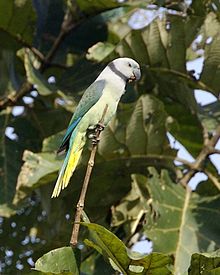- Blue-winged Parakeet
-
Malabar Parakeet 
Adult male Conservation status Scientific classification Kingdom: Animalia Phylum: Chordata Class: Aves Order: Psittaciformes Family: Psittacidae Genus: Psittacula Species: P. columboides Binomial name Psittacula columboides
(Vigors, 1830)[2]The Malabar Parakeet also known as the Blue-winged Parakeet, (Psittacula columboides) is a species of parakeet endemic to the Western Ghats of southern India. Found in small flocks, they fly rapidly in forest clearings while making screeching calls that differ from those of other parakeet species within their distribution range. Their long blue tails tipped in yellow and the dark wings with blue contrast with the dull grey of their head and body. Adult males and females can be easily told apart from the colour of their beak.
Contents
Description
The Blue-winged Parakeet is bluish grey with a long yellow-tipped tail. The black neck ring is complete in both males and females. The male has a bluish-green lower edge to the black collar and the upper mandible is red with a white tip while the female has an all black bill and has only the black collar. The female looks similar to the female of the Plum-headed Parakeet which however can be told apart by its broad yellow collar. Flocks move through the forest while calling out in a series of screeching keek-keek-keek calls.[3][4]
They breed in the dry season after the northeast Monsoon and the chicks fledge before the southwest Monsoon in June. They nest in holes in trees (often tall Mesua ferrea species[5]), especially old woodpecker and barbet nests. The birds begin breeding in December and eggs are laid in December and January. The usual clutch was 4 eggs which hatch after about 23 days. The female initially broods with the male bringing food and later the male takes over. The chicks fledge in about a month and leave the nest. Chicks are sometimes trapped for trade.[6] Individuals have been observed feeding on the leaves of Loranthus longiflorus.[7]
Distribution
This parakeet is restricted to the Western Ghats south of about 19°N (Kasa, north of Bombay) to Kerala, extending into the hills of the Palnis and Nilgiris[5] as well as the adjoining Eastern Ghats including the Biligirirangan range[8] and possibly further east in the Kolli Hills.[9]
In culture
This species is sometimes traded although now illegal within India. It was known in the pet trade as the "Bababudan Parrot" and acquired a misleading reputation as a superior talker.[5]
References
- ^ BirdLife International (2009). "Psittacula columboides". IUCN Red List of Threatened Species. Version 2011.1. International Union for Conservation of Nature. http://www.iucnredlist.org/apps/redlist/details/142569.
- ^ Vigors,NA (1830) Notice on some new species of birds. Zoological Journal 5:273-275.
- ^ Rasmussen PC & JC Anderton (2005). Birds of South Asia. The Ripley Guide. Volume 2. Washington DC & Barcelona: Smithsonian Institution and Lynx Edicions. p. 220.
- ^ Blanford, WT (1895). The Fauna of British India, including Ceylon and Burma. Birds. Volume 3.. London: Taylor and Francis. p. 255. http://www.archive.org/stream/faunaofbritishin03oate#page/255/mode/1up/.
- ^ a b c Ali S & SD Ripley (1981). Handbook of the Birds of India and Pakistan. Volume 3 (2 ed.). New Delhi: Oxford University Press. pp. 185–187.
- ^ Gokula, V & C Venkatraman (2003). "Foraging and breeding biology of the Malabar Parakeet Psittacula columboides in the Siruvani foothills, Tamil Nadu, India". Forktail 13: 138–139. http://www.orientalbirdclub.org/publications/forktail/19pdfs/Gokula-Malabar.pdf.
- ^ Apte S (2004). "Blue-winged Parakeet Psittacula columboides, Family Psittacidae, feeding on Loranthus leaves". J. Bombay Nat. Hist. Soc. 101 (1): 155.
- ^ Srinivasan, U. & Prashanth, N.S. (2006). "Preferential routes of bird dispersal to the Western Ghats in India: An explanation for the avifaunal peculiarities of the Biligirirangan Hills". Indian Birds 2 (4): 114–119. http://www.indianbirds.in/pdfs/Preferential%20routes%20of%20bird%20dispersal%20to%20the%20Western%20Ghats%20in%20India.pdf.
- ^ Karthikeyan, S (1996). Bird attracting trees and birds of Shevaroys and Kolli Hills. 36. pp. 49–51. http://www.archive.org/stream/NLBW36_3#page/n8/mode/1up.
External links
- World Parrot Trust Parrot Encyclopedia - Species Profiles
- Oriental Bird Images: Malabar Parakeet Selected photos
Categories:- IUCN Red List least concern species
- Parrots
- Psittacula
- Birds of India
Wikimedia Foundation. 2010.



